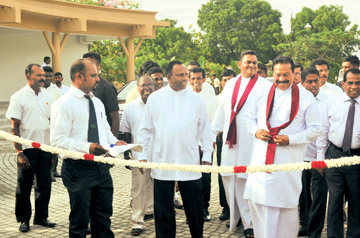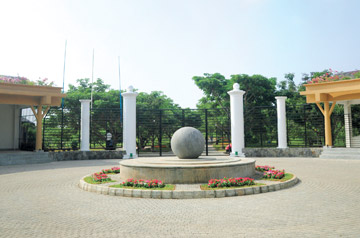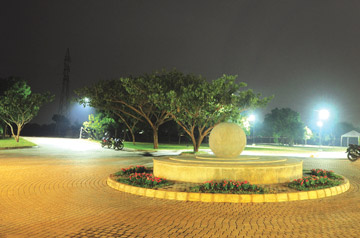Hambantota Botanic Garden, a new tourist attraction
By Dhaneshi Yatawara Following a tour in Hambantota
To mark the Commonwealth Heads of Government Meeting 2013 a
Commonwealth Circle was set up in the newly opened Dry Zone Botanic
Garden in Hambantota. Three presidents, seven vice presidents, four
prime ministers and several foreign ministers representing heads of
governments planted medicinal trees at the Hambantota Botanic Gardens
forming the Commonwealth Circle at the centre of the Garden.
 |
| President
Mahinda Rajapaksa opens the Botanic Garden |
 |
| The entrance
to the botanic garden |
 |
The garden was open to the public by President Mahinda Rajapaksa on
November 14. The Commonwealth Circle is a landmark for this garden being
the first botanic garden in Sri Lanka built in 130 years.
Bio-diversity
This Dry Zone Botanic Garden shows Sri Lanka's unique bio diversity.
The site of the new botanic garden, at Mirijjawila near Hambantota in
Southern Sri Lanka, was covered with thorny shrubs and abandoned chena
lands, when allocated for this purpose in 2006. "Developing a new
botanic garden in Sri Lanka is a major undertaking. It takes years to
develop and grow.
The new garden has to meet the many expectations and the needs, of a
wide range of people for the new century," said Dr. Siril Wijesundara,
Director General of the Department of Botanic Gardens.
"Many people ask whether a garden in a dry and arid area such as
Mirijjawila could be set up. Some think that it is a futile exercise and
waste of money. Others think that it is not a priority. We had all our
gardens in the Dry Zone during the time of Sri lankan Kings. We migrated
into wetter or more cooler areas. We are a nation who had gardens in the
dry zone. It is nothing new," said Dr. Wijesundara.
Since it is located on the 'adi siye para' (the road with a 100 metre
width) it is the miracle of adi siye para.
Conservation
The dry zone of Sri Lanka represents a substantial portion of our
forest ecosystem, and much of it has been lost during the past decades.
Tropical Dry Mixed Evergreen Forests and Tropical Thorn Scrub Forests
compose a major part of Sri Lanka's forest eco system. It has been on
the top two forest types that covers a larger part of our country.
"There is also ample evidence of climate change in the area as a direct
result of habitat losses. Human activity relies on a good climate and
our dependency on dry zone habitat is clearly rationale for its
conservation," said Dr. Wijesundara. Three water tanks Kohombagas wewa,
Malitthangas wewa and demataththa wewa, are in the garden premises to
preserve the moisture of the land.
"These tanks existed in this land and they were abandoned at the time
construction work started," Dr. Wijesundara said.
"The benefits of conserving dry zone habitat and its distinctive
vegetation are long term. The rich agro-biodiversity in the island's
farming systems is facing many threats due to unplanned land use,
pollution, fragmentation and alteration of farming methods. By
conserving the genes the agrobiodiversity in the dry zone could be
safeguarded," said Dr. Wijesundara.
Accordingly it is these plants that would care the drought resistant
genetics. It would be a main source in researches for developing new
agricultural crops to suit climate changes. Thus raises the dire need
for ex situ conservation of such plants.
There are no models or standards to set up a dry zone botanic garden
in the world, according to Dr. Wijesundara. "In the twenty first century
there is no requirement to follow traditional or classical pattern," Dr.
Wijesundara added explaining the landscape of the garden. "The few dry
zone botanic gardens in the world, particularly in Australia and in
North America are different from each other either. So there is no
pattern, design or precedent to follow," he added.
Benefits
For the Botanic Garden Department this is an opportunity to define a
space, a garden layout, landscape design and distinctive public amenity
in a modern way.
A new public amenity will boost the local market and promote economic
development. "A new public amenity creates direct and indirect economic
benefits" said Dr. Wijesundara.
Southern Sri Lanka has been earmarked as a development zone for
tourism, and a Botanic Garden will attract visitors. The new garden will
not only support and encourage tourism it will also promote tourism
related services such as accommodation, travel and product sales.
Floriculture has also been highlighted as an area of national policy
priority and where worldwide growth is also marked significantly.
According to Dr. Wijesundara, the long term strategic benefit of the
garden lies in its ability to take plants conserved ex-situ and to
promote the herbal and floriculture industries, where there is
significant potential for growth internationally. "Both of these
industries can be developed to meet the market potential as they hold
strategic value and there are economic benefits to be gained in these
areas especially with the operation of Mattala Rajapaksa International
Airport nearby," he added.
|

